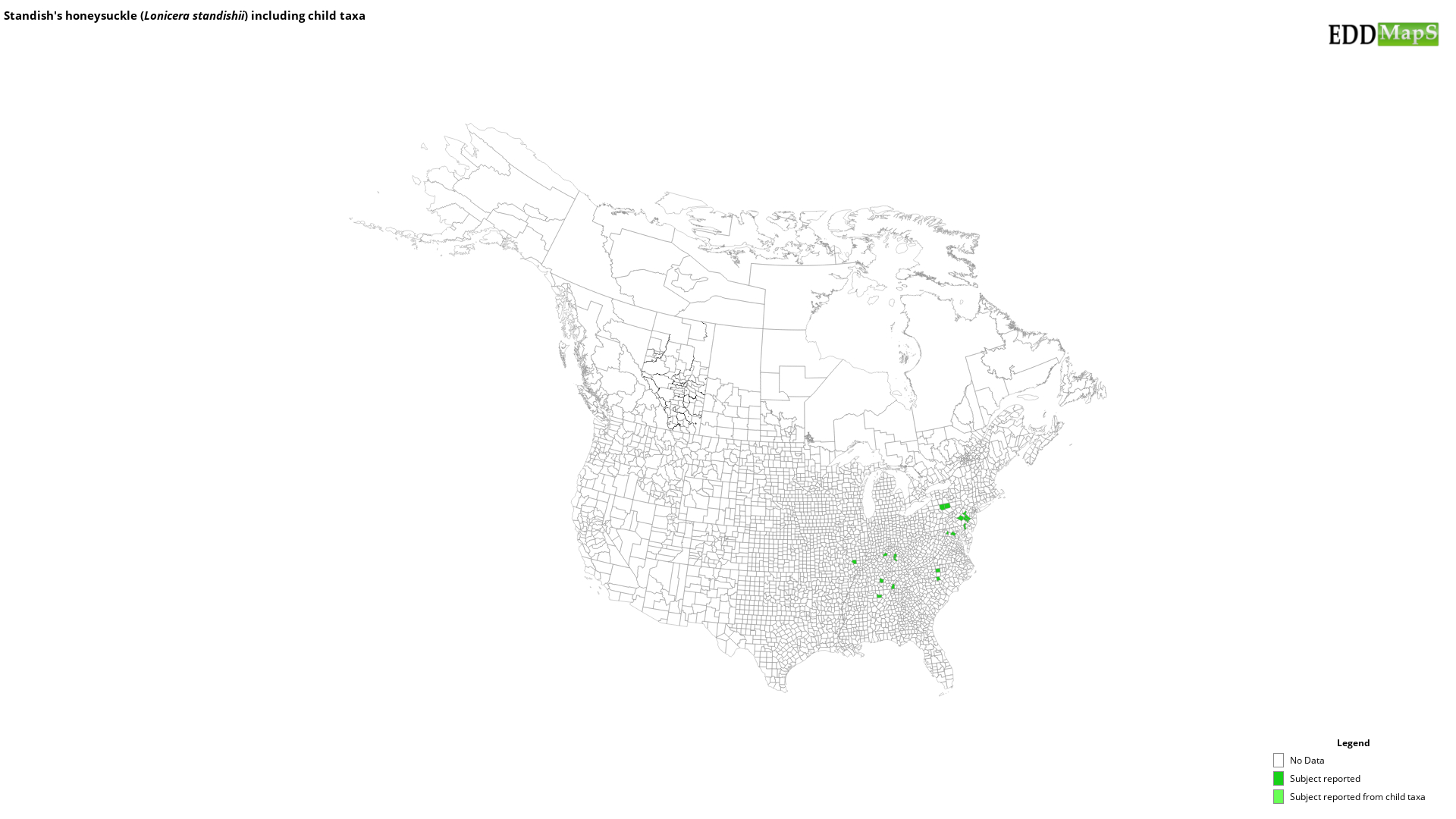Standish's honeysuckle
(Lonicera standishii)
This species is Introduced in the United States
Appearance
Lonicera standishii is an upright, shallow-rooted deciduous shrub that grows up to about 8 ft (2.4 m) tall. It has a solid, white pith. Branches are covered with stiff reddish-brown hairs. It has pale, shredding bark. L. standishii is native to temperate Asia.
Foliage
The opposite leaves are ovate to oblong with smooth, rolled down margins. They have a blunt or short pointed tip. The leaves right below the inflorescence encircle the stem.
Flowers
The white flowers are showy and fragrant. Five petals with four fused into a 4-lobed lip at the top and a 1-lobed lip at the bottom and petals are pilose (hairy) on the exterior; ovaries are fused. It blooms from February to March.
Fruit
Fruit are bright red berries, about 0.25 in (0.6 cm) in diameter. The berries are eaten and spread by wildlife.
Ecological Threat
L. standishii invades a variety of habitats, displacing native shrubs and herbaceous plants, and limiting tree regeneration. It leafs out early and remains green longer than many native plants. L. standishii can deplete soil moisture and nutrients. It is allelopathic, so it can inhibit the growth of nearby plants.
Lonicera standishii is an upright, shallow-rooted deciduous shrub that grows up to about 8 ft (2.4 m) tall. It has a solid, white pith. Branches are covered with stiff reddish-brown hairs. It has pale, shredding bark. L. standishii is native to temperate Asia.
Foliage
The opposite leaves are ovate to oblong with smooth, rolled down margins. They have a blunt or short pointed tip. The leaves right below the inflorescence encircle the stem.
Flowers
The white flowers are showy and fragrant. Five petals with four fused into a 4-lobed lip at the top and a 1-lobed lip at the bottom and petals are pilose (hairy) on the exterior; ovaries are fused. It blooms from February to March.
Fruit
Fruit are bright red berries, about 0.25 in (0.6 cm) in diameter. The berries are eaten and spread by wildlife.
Ecological Threat
L. standishii invades a variety of habitats, displacing native shrubs and herbaceous plants, and limiting tree regeneration. It leafs out early and remains green longer than many native plants. L. standishii can deplete soil moisture and nutrients. It is allelopathic, so it can inhibit the growth of nearby plants.
Selected Images
Maps
EDDMapS Distribution - This map is incomplete and is based only on current site and county level reports made by experts, herbaria, and literature. For more information, visit www.eddmaps.org
State Lists - This map identifies those states that have this species on their invasive species list or law.
Invasive Listing Sources
- Commonwealth of Pennsylvania, Department of Conservation and Natural Resources, 1994.
- Invasive Plant Species of West Virginia
- Jil M. Swearingen, Survey of invasive plants occurring on National Park Service lands, 2000-2007
- Maryland Department of Natural Resources Policy: Restriction on Planting Exotic Invasive Plants
- Maryland Invasive Species Council - Invasive Species of Concern in Maryland
- National Park Service, Mid-Atlantic Exotic Plant Management Team Invasive Plant List
- Nonnative Invasive Species in Southern Forest and Grassland Ecosystems
- Pennsylvania Department of Conservation and Natural Resources Invasive Plants
- WeedUS - Database of Plants Invading Natural Areas in the United States
- West Virginia Invasive Species Strategic Plan and Volunteer Guidelines 2014
- West Virginia Native Plant Society, Flora West Virginia Project, and West Virginia Curatorial Database System, September 3, 1999
Taxonomic Rank
| Domain: Eukarya |
| Kingdom: Plantae |
| Phylum: Magnoliophyta |
| Class: Magnoliopsida |
| Superorder: Asteranae |
| Order: Dipsacales |
| Family: Caprifoliaceae |
| Genus: Lonicera |
| Lonicera standishii |
References
Common Name Reference: USDA, NRCS. 2010. The PLANTS Database. National Plant Data Center, Baton Rouge, LA, USA.
Scientific Name Reference: USDA, NRCS. 2010. The PLANTS Database. National Plant Data Center, Baton Rouge, LA, USA.


